In Part 1 of our Intro to Incrementality series, we covered the fundamentals-measuring incremental lift by comparing test (exposed) and control (holdout) groups. In Part 2, we explored how to create accurate control groups using ghost bidding to eliminate bias and avoid skewing incrementality analysis.
Now, in this final installment, we’ll show you how to apply incrementality analysis in real time to optimize your campaigns, improve ROI, and make smarter marketing decisions. From uncovering granular insights to factoring in cost, incrementality isn’t just about measurement—it’s about actionable optimization.
Let’s revisit our basketball analogy a final time: An NBA team hires a shooting coach for one of two players, both of whom start with a 40% free throw success rate. After a year, Player B—who worked with the coach—improved to 80%, while Player A improved naturally to 50%.
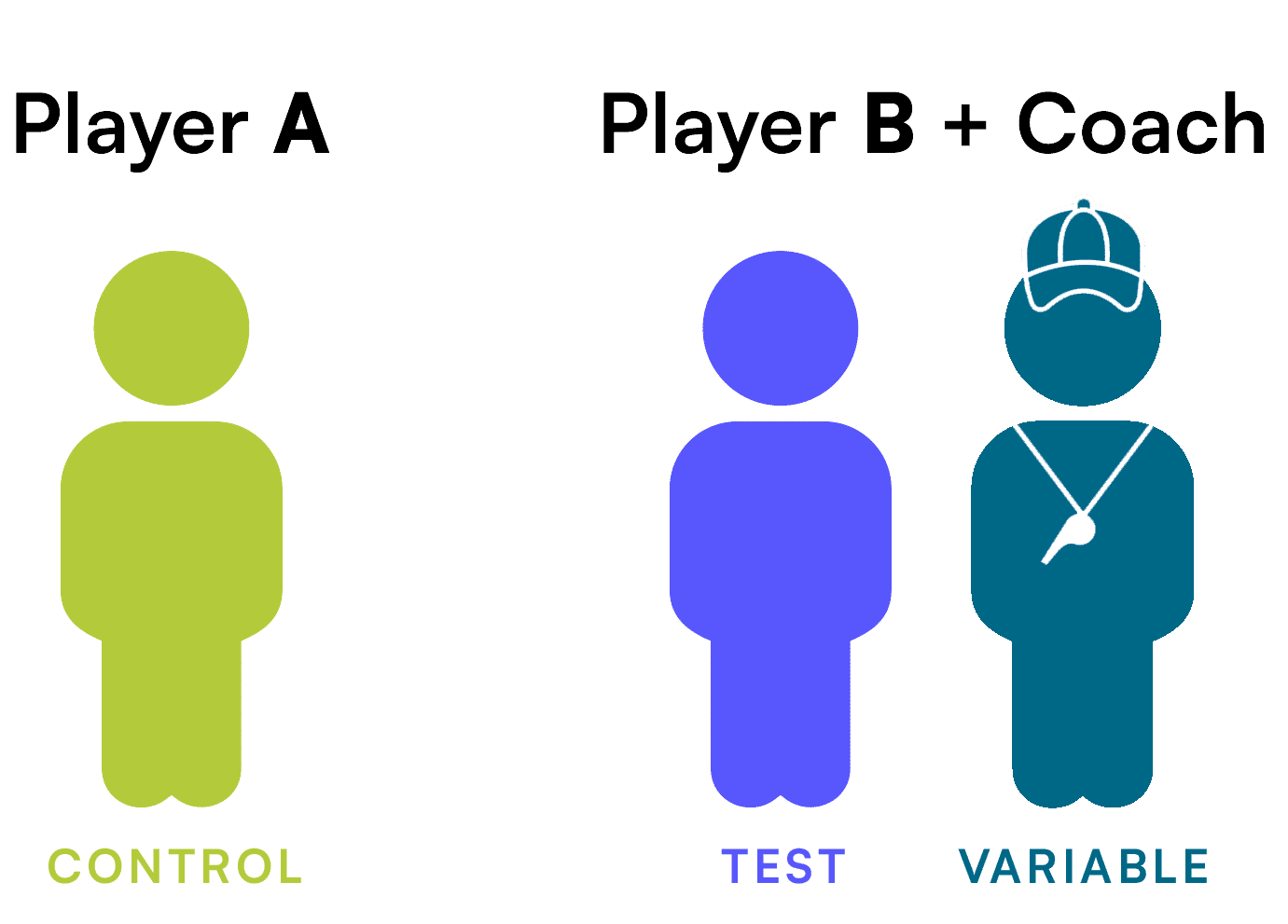
This analogy illustrates the basics of incrementality: the test group (Player B), the control (Player A), and the new variable (the coach). However, it neglects some real-world complexities:
Marketing is no different. Incrementality analysis is messy, nuanced, and ongoing. Let’s clean up the mess.
To make incrementality actionable, brands and agencies must embrace three key principles:
1. Real-Time Analysis
Incrementality isn’t a one-and-done exercise. Marketers don’t have unlimited budgets or the luxury of testing campaigns in isolation. Real-time analysis allows brands to adjust strategies dynamically, optimizing performance as results unfold.
For instance, incrementality after two weeks may differ from results after two months-but early insights can still drive valuable decision-making.
2. Granular Insights
Broad media type analysis (e.g., evaluating all CTV campaigns together) can only tell you so much. Granular insights-breaking down performance by publisher, audience, or creative-are essential for actionable optimization.
For instance, instead of asking whether CTV works, ask which publishers (e.g., Hulu vs. Pluto TV), audiences (e.g., intent-based vs. demographic-based), or creatives (e.g., :15 vs. :30-second spots) deliver the most incremental value.
3. Money Matters
Incrementality analysis is incomplete without factoring in cost. Metrics like cost per incremental action (iCPA) and incremental return on ad spend (iROAS) go beyond traditional cost per action (CPA) and last-touch attribution to ensure your budget is allocated toward the most effective tactics.
A brand adds a $1k CTV test campaign to its marketing mix, which previously included only search and social media. The goal is to optimize to the lowest cost per action (CPA). The campaign tests one creative, one intent-based audience, and three publishers: Hulu, Sling, and Pluto TV.
Here’s the performance data from the CTV campaign based on checkouts and CPA:

At first glance, Sling appears to be the top performer due to its low CPA. But incrementality analysis provides a different perspective:
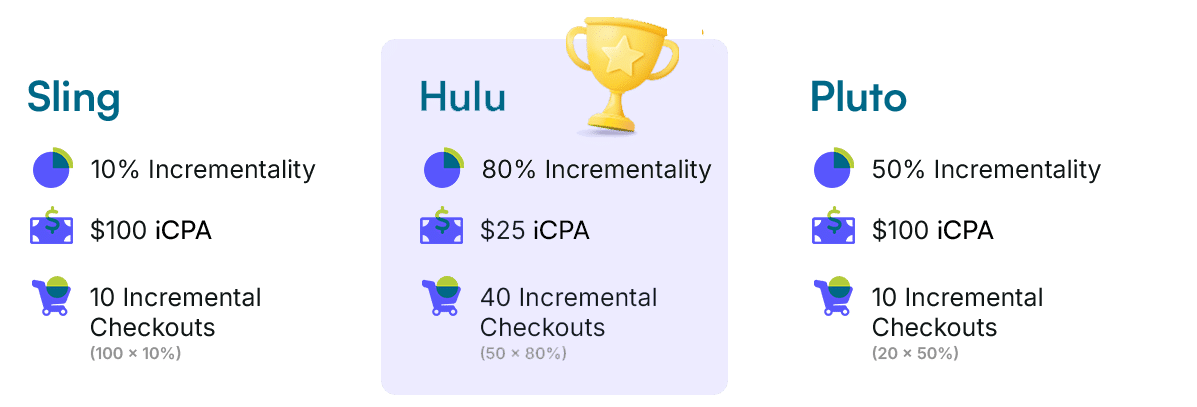
The takeaway? Without incrementality analysis, the brand would have funneled more budget into Sling, optimizing its campaign in a way that was actually counter to its bottom line, toward conversions that would have happened anyway. By incorporating incrementality, it sees that Hulu delivers the lowest cost per incremental action (iCPA) and can reallocate budget accordingly.
This example highlights a common marketing pitfall: platforms and publishers often overreport conversions by attributing them to their own channels, regardless of cross-channel interactions. Incrementality analysis cuts through this noise, giving marketers a clearer picture of which ads and channels drive true incremental results.
Using metrics like iCPA and iROAS ensures smarter budget allocation—not just within a single channel but across your entire media mix.
As brands and agencies become more strategic about their marketing budgets and cross-channel complexity continues to grow, incrementality analysis is no longer optional but essential. It doesn’t just track performance—it answers the fundamental question: Did this ad actually cause the action, or was it just along for the ride?
By working with a media execution partner that applies real-time, granular, and cost-aware optimization strategies, brands and agencies can ensure their media spend drives true impact on marketing performance and business results.
The Digital Remedy Platform not only offers incrementality analysis as a standard feature but also enables advanced ad optimization, ensuring every media dollar is strategically allocated to deliver measurable success.
Ready to make every dollar count? Speak with a member of our team today to learn how incrementality can revolutionize your marketing strategy.
The age-old maxim of “think globally, act locally” isn’t just embraced by marketers for local mom-and-pop businesses. Today, massive multi-location brands and franchises are taking a local-first approach to their performance marketing strategies, helping them better resonate with their target audience.
As customer spending and viewing habits change and the demand for more unique and personalized experiences skyrockets, advertisers are responding by steering their budgets toward regional markets.
For regional marketing managers, whose success is inherently tied to the performance of the stores within their territories, embracing a local-first strategy has never been more crucial..
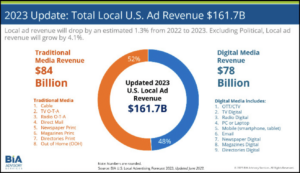
Source: BIA Advisory Services
Based on BIA Advisory Services’ 2023 Total Local U.S. Ad Revenue report findings, key sub-sectors, like automotive, are poised for local growth as we close out the year.
BIA also revises upward its projections for Tier 3—new car dealers and automotive repair services. Other sectors seeing an optimistic adjustment in advertising expectations include financial institutions, loan services, plumbing and HVAC services, and real estate agencies. While political advertising is projected to be a major category in 2024, BIA projects initial spending to kick off in late 2023.
According to eMarketer, local television stations will likely gain from a rebound in automotive advertising as vehicle stock levels rise.
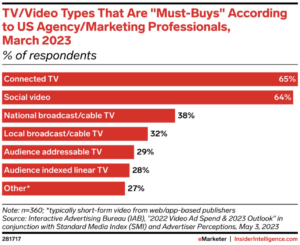
Source: eMarketer
Pre-pandemic, local TV derived approximately 20% to 25% of its advertising revenue from the automotive industry.
There is room for improvement. In February 2023, the automotive industry saw a steep 66.8% drop in the U.S. TV advertising expenditure, attributed mainly to fewer car companies buying high-priced ads for the Big Game than in the previous year, 2022.
There’s no one-size-fits-all approach to regional advertising, but the perks apply to just about any industry and brand—startup shop or national corporation.
When you harness the power of local advertising, you benefit your bottom line through:
Political advertisers especially benefit from local advertising. By investing in local campaigns, they’re able to deliver messaging by region and specific voter districts to achieve targeted impact, drive issue-specific campaigns, and mobilize grassroots support more effectively.
Similarly, national advertisers often opting to buy the most populous markets can reach untapped ones and close any gaps through 100% designated market area (DMA) coverage.
Connected TV (CTV) brings together two key digital agency solutions—the reach of traditional TV and the pinpoint accuracy of streaming—making it an ideal tool for local advertising.
The pillars of its effectiveness lie in its targeting capabilities, creative approaches, and chosen inventory.
The most successful local CTV campaigns use a 360-degree targeting strategy to reach the audiences that perform. These campaign components encompass a mix of tactics, including:
Geo-fencing is ideal for:
Among many other industries, quick-service restaurants (QSRs) reap the many rewards of localized targeting. No matter what they’re whipping up in the kitchen, these eateries can communicate new menu items and promotions available within the region.
If you’re already prioritizing local marketing in your CTV strategy, how well is your creative performing?
The success of your campaign will only be as good as your creative ingenuity.
One particularly effective method is the use of interactive ad formats. Not your run-of-the-mill commercials, these ads invite your audience to engage directly with the content, transforming passive viewers into active participants.
For example, QR codes can be integrated into your CTV ads to bridge the gap between the TV screen and the viewer’s mobile device. A simple scan of the code could take the viewer to a landing page, promotional site, or even a digital shopping cart—encouraging immediate action.
Similarly, dynamic creative allows you to automatically tailor the content based on real-time data. This could mean adjusting the ad’s messaging or visuals depending on factors like the viewer’s location, time of day, or even the current weather conditions.
These creative methods are personalization at its finest, serving up a hyper-relevant experience for each individual viewer.
In the CTV advertising ecosystem, inventory isn’t just a list of available slots—it’s your stage, your platform, and your battleground.
Choosing premium OTT publishers places your brand in elite company, aligning your message with high-quality content that your audience already trusts and enjoys, like live sporting events.
With inventory software, you can leverage premium video ad supply and share your message both:
Plus, take advantage of real-time customization capabilities to adapt and fine-tune your messaging for maximum impact.
With Digital Remedy, you can optimize your regional CTV advertising strategies and gain a better understanding of your local audiences across the board.
Our digital media solutions support the unique goals of all our local partners—retailers, venues, dealers, franchisees, agents, and more—whether it’s to boost brand awareness or drive store/dealership traffic. To give you a holistic overview of your performance, we can also execute a foot traffic study to examine how your digital media channels are contributing to your on-site visits.
From national to proximity-based targeting, we have the power to get as granular as your brand needs. With our innovative media solutions, premium inventory access, and a regional sales team as your performance media partner, we’ll help you leverage these granular insights into your customers with greater levels of measurability to help you better understand what is and isn’t working. We have vast experience optimizing towards the full scope of your KPIs and have successfully executed everything from branding and engagement, down to site visits and ROAS.
Ready to get the most out of your regional marketing efforts? Let’s talk.
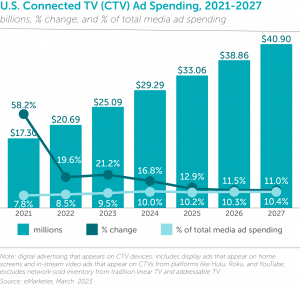
Ad spending on CTV platforms continues with a projected increase of advancements and opportunities in the over-the-top (OTT) and connected TV (CTV) advertising space. As consumer viewing habits continue viewing streaming services ad dollars continue to migrate toward these channels as well.
The industry built tools to better target streaming audiences and measure their viewing behaviors, with the goal of providing the most compelling ad opportunities for marketers looking to connect with valuable consumers. Making up 10% of all digital ad spending, CTV ad spending is expected to reach $29.29b in 2024.1
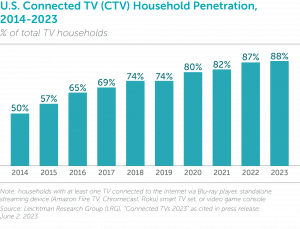
Connected TV penetration in U.S. households continues to grow, as more households acquire internet-connected devices to watch content.2
CTV’s ability to merge the often separated performance and brand marketing worlds is redefining the digital advertising space as we once knew it. Given the immense ad opportunities that CTV/OTT offers—including precise, digital-like measurability and a high-quality viewing environment and the valuable audiences it draws in—and the significant investment in these channels, advertisers and brands are increasingly focused on proving the effectiveness of their OTT campaigns.
Through next-generation CTV ad platforms, marketers can now understand the CTV exposure-to-outcome impact of their ads. Given the large investment in this media channel, attribution—the process of assigning credit for conversions to various marketing touchpoints along the customers’ journey—has become a must-have for growth and performance marketers. This information is critical to creating more effective ad campaigns and boosting revenue. In measuring conversions following ad exposure for CTV, it’s important to understand which exposure caused the conversion to take place. For example, if a person sees an ad for Jersey Mike’s Subs on CTV and grabs their phone to do a quick search for the nearest location, then clicks on the link and places an order. This behavior will be attributed to Google, while in fact the search and the sale were 100% inspired by the TV ad. This faulty attribution dynamic has played out for years, resulting in hundreds of billions of dollars in valuation being hijacked by last-click digital companies.
While some attribution models use basic analytics data, they only provide a template and often fail to account for important steps in the marketing funnel. While last-touch attribution has long been the “go-to” measurement method, marketers now need to explore different attribution methodologies, given the increasingly fragmented media space and evolving consumer journey. The digital ad space needs to advance our understanding of single-touch measurement models, as they assign 100% of conversion credit to only one marketing touchpoint and often focus on only the first or last interactions, and adapt more sophisticated methods of analysis for campaigns. By leveraging different attribution methodologies, marketers can gain more in-depth insights regarding ad effectiveness to drive future marketing decisions.
It’s important to understand that attribution is a journey and the consumer journey is ever-changing. Today, a person can be exposed to a brand’s ad across numerous platforms and devices before purchasing. In fact, in the modern age of marketing across platforms, devices, and channels, the typical retail consumer requires an average of 56 touchpoints before making a purchase.3 It is important to assign proper credit to each touchpoint so that marketers can determine where their budget should be spent.
Our award-winning proprietary Performance CTV platform matches and tracks OTT/CTV impressions across premium inventory sources to real-world events, including site visits, store location visits, subscriptions, app installs, form-fills, purchases, revenue, and more to provide a more granular look at the consumer journey. We know, deterministically, at the household level, when someone is exposed to an ad and then takes action—whether it be digitally or physically. With our platform, advertisers can analyze exactly what’s driving desired results among consumers using multiple attribution methodologies.
Our Performance CTV platform takes attribution a step further, measuring every single touch prior to a conversion. Powered by innovative technology, the platform allows users to toggle freely between four different attribution methodologies in real-time to see exactly which touchpoints are driving the most leads, sales, installs, or visits among consumers. Advertisers have the ability to shuffle the distribution of credit according to the following attribution methodologies:

First Touch: All conversion credit assigned to the first variables that the converter was exposed to.

Last Touch: All conversion credit assigned to the last variables that the converter was exposed to.

Time Decay: Credit weighted more heavily across variables that the converter was exposed to as said exposures approach conversion (aka credit increases as time to conversion decreases).

Linear: Credit evenly dispersed across all variables that the converter was exposed to.
Our Performance CTV platform is the one-stop-shop for advertisers and agencies looking to transform data into actionable items that can be leveraged and improved upon in the future. By measuring and assigning credit to different variables in your campaign, our platform determines the true impact of each of them on any KPI—providing a new standard in tracking, transparency, and results via comprehensive attribution insights. Our platform then uses these insights to inform its media buying with a bidder that moves the budget toward the highest-performing campaign variables—lowering CPAs, maximizing ROAS, and making a tangible impact on a brand’s bottom line. Expanding your attribution methodologies will not only help refine your budget strategy but will have a lasting impact on your current and future ad campaigns.

Sources:
In recent years, QR code ads have been getting lots of buzz in marketing circles—with most conversations centering around using them in performance TV campaigns to drive outcomes.
The evolution of QR code formats in recent years has led some marketers to seek a refresher course on the subject.
So, what are QR code ads, and what’s the best way to use them in your digital advertising campaign?
QR codes were created by Denso Wave, a Toyota subsidiary, in 1994 as a way to track vehicles and their parts during the manufacturing process more accurately. While Denso Wave’s creation certainly wasn’t dormant in the years following, QR codes didn’t see widespread adoption until the 2020 COVID-19 pandemic, when contactless mobile payment became necessary—leading to the widespread acceptance of QR codes globally.
This, along with the rise of smartphone usage and streaming content consumption during the pandemic, created an opportunity for marketers to pivot to using QR codes in their connected TV campaigns.
QR codes deliver an innovative, immersive, and intent-driven consumer ad experience that matches perfectly with the eye-grabbing nature of television ads.
Pair this with the fact that 70% of consumers use mobile devices while watching TV, according to Marketing Dive, and you have the perfect opportunity for QR code ads to thrive.
For example, in their 2022 spot for The Big Game, crypto tycoon Coinbase created the most talked about ad of the year by displaying a simple color-changing QR code that bounced around viewers’ screens for 30 seconds.
Scanning the code led users to their crypto exchange platform, where they were given $15 of Bitcoin to create an account.
Crypto and tech companies aren’t the only ones using QR codes in their connected TV campaigns. Legacy brands like Burger King and Lacoste are also getting in on the action—proving the simple, efficient, results-driven nature of QR code advertising is here to stay.
QR code stands for “Quick Response Code,” which is probably the simplest definition of what this 2D barcode does.
Similar to barcodes you find at grocery stores, QR codes are made up of black squares and tiny dots representing different pieces of information. Once scanned by your smartphone, these unique patterns translate into human-readable data such as menus, landing pages, and websites.
There are two types of QR codes you should be aware of while developing your ads strategy.
Static QR codes are permanent and cannot be modified once they go live—making it even more important to be sure you eliminate all typos. Because these codes never expire, they are ideal for storing fixed information.
You can use static QR codes for email addresses, texts, WiFi passwords, social media links, and much more.
The three main features of static QR codes are:
Dynamic QR codes can be modified and store more data after posting.
This type of QR code is ideal for those looking for more access to monitoring real-time scans and the location of where people are scanning.
Some, but not all, of the features of dynamic QR codes, include:
The days of static CTV ads are over, and QR codes are leading the way. Including a QR code in your CTV ad on platforms like YouTube TV gives your audience an easy way to visit your landing page and engage with your product. Plus, the ability to measure the traffic from your CTV ad means you can optimize your campaign in real time.
But QR codes aren’t just a novelty—they can significantly impact your bottom line. With the right call-to-action, your QR code can drive highly-targeted audiences to product pages and checkout screens, boosting conversions and increasing revenue. Marketers serious about meeting their lower-funnel KPIs should pay attention to QR codes’ power and other interactive ad formats.
If used correctly, QR codes can spike the curiosity of your customers and prospects alike.
Here are some tips for maximizing campaign performance:



Regardless of your digital campaign objectives, finding a partner that can seamlessly optimize your strategy is essential. With Digital Remedy, you can leverage dynamic creative video, including adding and optimizing QR codes for CTV and inserting a QR code add-on to a raw asset CTV file. This helps to further engage with users in a CTV environment and prove your conversion was because of direct interaction with an ad.
With our always-on ad serving, personalization, and measurement, we can help you choose the best QR code campaign to maximize your ROAS.
Digital Remedy partners with a leading offline-to-online (O2O) tech platform powered by next-generation QR codes. Decide on custom designs; we’ll help you decide on the best place to send consumers after they scan and optimize for maximum scannability. Data dashboards and reports can be customized based on your KPIs. Reporting includes variables to test, data insights, and overall learnings. We provide real-time analytics, geo-location data, and attribution across screens.
Ready to take your CTV campaigns to the next level with QR codes? Speak with a member of our team to learn more.
As the direct-to-consumer (DTC) space becomes increasingly competitive, marketers are under constant pressure to understand campaign performance and prove the value of their efforts. Now accountable for driving outcomes through their campaigns rather than building general awareness among consumers, many brands are rethinking their media mix—exploring new channels that can effectively deliver on their campaign goals and maximize their budget.
Digital Remedy partnered with Dynata, the world’s largest first-party data company, to field a marketing-focused survey with the goal of gaining a deeper understanding of DTC marketers’ top priorities, current campaign practices, and media partner preferences.
Download our report, which provides valuable insights, including:
For the latest industry trends and insights, check out our blog and sign up to receive our monthly newsletter.
Whether you’re a DTC marketer just getting started in the CTV/OTT space or looking to take your current campaigns to the next level, Digital Remedy is here to help. Discover how your brand can garner greater brand impact, generate more outcomes, and turn TV into a powerful performance channel. For additional information, visit www.digitalremedy.com/ott-ctv or schedule a demo to see our award-winning platform in action.
Through sophisticated measurement capabilities, marketers can now understand the impact of CTV exposure-to-outcome on their ads. Given the significant investment in this media channel, attribution—the process of assigning credit for conversions to various marketing touchpoints along the customers’ journey—has become a must-have for growth and performance marketers. This information is critical to creating more effective ad campaigns and boosting revenue. In measuring conversions following ad exposure for CTV, it’s important to understand which exposure caused the conversion to take place.
Through incrementality analysis, we can evaluate all the conversions that wouldn’t have happened without our media. However, in many instances, other media channels had an influence. In fact, every touchpoint your audience has with your campaign influences a conversion—no matter the partner or channel.

If a Digital Remedy campaign played a part in a conversion that involved other media exposures, clients want to understand how the exposure to Digital Remedy played a role in improving the efficacy of the media. In this case, the OTT campaign influenced the conversion, but the second partner’s attribution modeling wouldn’t take that into account, and it would get full credit for the conversion.

All media works together. None of your advertising works in a vacuum. Conversion reporting/attribution is only one of several ways to analyze whether specific media works for you. With halo effect analysis, clients can understand the campaign boost Digital Remedy is providing. If we played a part in a conversion that involved some other media, we’re essentially improving the efficacy of that media type with our own media.
Incremental channel lift, or halo effect, is a way to measure the boost in performance of your search, social, and affiliate channels provided by your CTV campaigns. In other words, the halo effect shows how much more likely someone is to convert if they see CTV ads AND any of your search, social, or affiliate ads versus ONLY seeing ads on those other channels.
Halo effect analysis takes a more holistic approach to attribution, focusing on incremental conversions across media channels and campaigns. With this analysis, you can connect your CTV spend and see just how much of a boost these campaigns are providing for all of the other media you’re running.
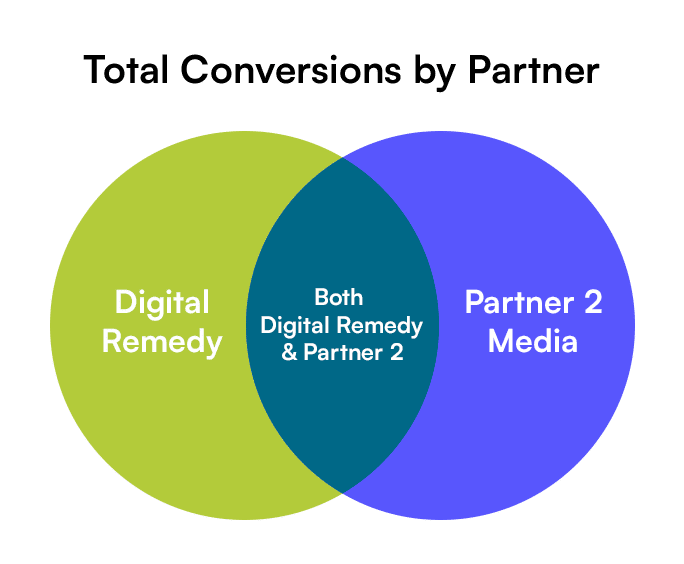
Rather than having to take credit for the direct performance of our media, we are able to assign that credit and take indirect credit instead through halo effect analysis. Search lift, social lift, affiliate lift, native lift; you name it, all of this can be done through this same process.
Leveraging halo effect analysis through Digital Remedy, advertisers can measure the true incrementality of their marketing initiatives and refine their campaign mix to deliver a better ad experience for their customers (and better results for their business). Benefits include:
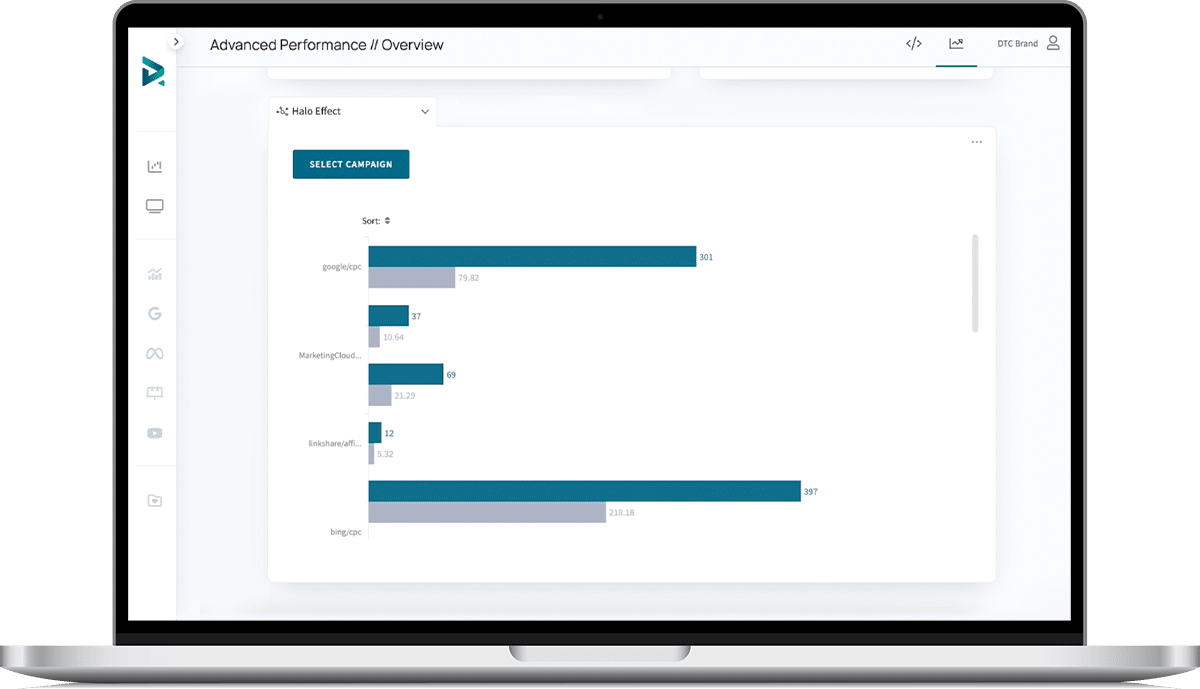
Speak to a member of our team to learn more.
With the lines between branding and performance marketing blurring, the days of archaic, one-size-fits-all ad campaigns are over.
Creating an OTT/CTV performance campaign that works and works well relies on a number of things, but what trumps the list in 2023 may be more holistic than what we’ve seen in past years.
To ensure your connected TV advertising efforts are optimized for success, you need to know what makes an effective performance marketing strategy aligned with today’s best practices.
When starting a connected TV campaign, marketers face a choice: Is this a branding or a performance campaign? Not that the two are wholly mutually exclusive—a branding campaign will have a performance impact and vice versa—but the choice between the two will determine the primary campaign objective.
With a branding campaign, your main goal is to build brand equity—establishing your value proposition regarding your reputation, values, quality of offerings, and trustworthiness, all in the minds of your customers. This type of marketing is mainly used to raise awareness about your overall brand, or it can be an effective way to generate hype on the product level, particularly when it comes to a new launch.
These campaigns involve slow-burning strategies, and their return on investment may not occur immediately—rather, taking weeks, months, or even years to witness real results. Along the way, however, you can track KPIs to measure how well your brand is resonating with your audience with metrics like engagement and interaction.
On the flip side, performance marketing aims to improve brand performance and impact real-world outcomes like sales, leads, or site traffic. Digital marketers who choose this type of media planning strategy have high hopes of guiding their audiences through the marketing funnel all the way to conversion. Performance marketing implies 2 key facets:
With high-volume lead generation and quick, easily trackable ROI, performance marketing is favorable for immediate results or when budgets are tighter, where every out dollar must correspond to an equal or greater amount in. Powered by personalized messaging, clear calls to action, and compelling ad ideas, these campaigns encourage viewers to respond directly to the ads in ways that drive bottom-funnel KPIs.
Traditionally, branding and performance have existed as two completely separate disciplines: Branding as a long-term strategy; performance as a short-term one. Branding to drive perception; performance to drive demand. Branding as a trust builder; performance as a sales pitch.
The list goes on.
Fortunately, the gap between brand and direct response marketing is starting to close, and advertisers are no longer left scrambling to pick a side of the coin.
Measurements for what were once considered upper-funnel media channels are starting to improve, highlighting what many advertisers may have missed all along: Lower-funnel media can impact branding, and upper-funnel media can impact performance.
Brands are now paying equal attention to how they tell their story and the ways they target and measure their true impact.
Bridging the gap no longer entails a drastic shift in mindset—there’s an art and science to both that can never fully merge. But a clear alignment of the two will bring about a holistic, granular understanding of the effects of your cumulative investment, considering the nuances of every stage of the buyer’s journey.
When marketers combine the data, technology, and benefits of the two once-opposite disciplines, they can craft strategies with both long-term brand awareness and measurable outcomes.
Savvy marketers know that bringing an ad idea to life isn’t just about the desired outcome—it’s also about the right creative. With the average person seeing an estimated 6,000-10,000 ads a day, cutting through the clutter is no easy feat unless your ads are made to be remembered.
Whereas linear TV was once the traditional branding channel, recent advancements in ad tech have brought newer, more innovative opportunities to deliver an incredibly engaging audience experience.
OTT/CTV, in particular, offers the high-impact brand storytelling power of traditional TV coupled with the targeting, analytics, and interactivity of digital. These capabilities create a compelling environment for audiences to interact with messaging alongside premium content, helping to drive conversion rates.
When launching a creative strategy that works for your brand and advertising goals, it’s important to segment your marketing channels by funnel level and different messaging strategies based on customer touch points. You’ll need to plan to allocate your spending based on:
The right creative strategies look different for every marketer, and they aren’t built overnight. But with knowledge of the industry’s best practices, you can ensure your strategy is up to code, speed, and the standards of your target audience.
A performance marketing strategy that combines the best of both worlds—branding and direct response—can be a shot in the dark if not executed correctly. To avoid blindly firing into the abyss, you need to cultivate an expert media buying strategy that hits the target without misses.
Some of the industry’s best practices to keep in mind as you navigate a multi-dimensional performance marketing strategy include:
Discover how incrementality analysis helped our QSR client determine which creative messaging drove the highest incremental lift. From these insights, the client shot additional video spots that aligned with the high-performing messaging.
Performance means different things to different marketers (and has traditionally been associated with direct response). At Digital Remedy, we believe in having a solid base for delivering performance, no matter the KPIs (upper- or lower-funnel)—meaning more outcomes and more ROI for our clients.
We’ve spent 22+ years building and evolving the best performance solutions in the market—while providing a new standard in tracking, transparency, and results via comprehensive attribution insights.
Performance is at our core. Our omnichannel performance branding solutions enable advertisers and agencies to effectively activate, measure, and draw insights across the right channel to drive a stronger impact and performance outcomes.
We recognize the importance of understanding the complete consumer journey so that no marketing funnel stage is ever optimized in isolation. Your consumers’ attitudes and behaviors are bound to change—meet them where they are with a flexible, agile approach and platforms that evaluate your most effective journey to purchase.
Speak with a member of our team to learn more about how we can help you maximize your OTT/CTV performance strategy today.
TV viewership has dramatically changed. With declining linear TV audiences, and an industry shifting its focus towards Over-The-Top (OTT) and Connected TV (CTV) streaming services, advertisers are reallocating budgets to dive into this growing platform. Not only are more people using CTV, but time spent with this medium is also increasing. There have never been more options for what to watch and how to watch it.
Non-pay TV viewers will soon outnumber pay TV viewers. By 2024, 123.8m people will view pay TV, versus 143.6m who will have cut the cord, instead streaming content and watching live TV on distributors like Hulu + Live TV and YouTube TV. These shifts in viewership are opening up different ways for advertisers to target and reach TV watchers.
In this blog, we’ll cover everything advertisers need to know about YouTube TV (if you’re a viewer looking for more info on YouTube TV, go here) and how to leverage YouTube TV ads through Digital Remedy as part of your OTT mix.
We’ve all heard of YouTube, but what is YouTube TV? First launched in April 2017, YouTube TV is a subscription streaming service—known to advertisers as a vMPVD (Virtual Multi-Platform Video Distributor)—that provides an alternative to traditional cable. Available nationwide, YouTube TV lets subscribers watch live TV from 100+ broadcast, cable, and regional sports networks (in English and Spanish), in addition to video-on-demand (VOD) shows, YouTube Originals, and trending YouTube videos. Subscribers can upgrade their viewing experience with premium networks, sports, Spanish, and 4K plus add-ons for an additional monthly cost.
As of July 2022, YouTube TV has more than 5m accounts — making it the U.S.’s biggest internet-based pay TV service. In addition, it’s the fifth-biggest U.S. pay-TV service (after Comcast Xfinity, Charter Spectrum, DirecTV, and Dish).
YouTube TV service currently does not have an ad-free version, so all subscribers see ads. YouTube TV advertising is a form of OTT (over-the-top) advertising. OTT advertising is delivered directly to viewers over the internet through streaming video services or devices. With YouTube TV, advertisers can tap into one of the most premium CTV inventories to reach target audiences at scale, with robust data, optimization, and transparent reporting.
Not everyone who watches YouTube on their TV is a subscriber of “YouTube TV.” The YouTube app is already baked into or available for free download across many Smart TVs and streaming devices. The YouTube app enables viewers to watch all their favorite content on the largest screen in their house at no cost, while “YouTube TV” requires a paid subscription.
YouTube TV currently supports two types of ads:
This platform’s most significant advantage over cable TV is its Artificial Intelligence, which recommends content depending on the user’s preferences. Through advanced targeting, users can easily be targeted by:
Topic targeting lets brands reach people interested in content related to their products and services, whether travel, food, music, or something else. Topic targeting applies to non-skippable in-stream ads, and bumper ads served on YouTube TV.
With YouTube TV, ads can show up in a few different places:
This allows ads to be placed in relevant slots for target consumers as they already engage with the YouTube environment.
YouTube TV has become a valuable channel for advertisers looking to connect with the right audience at the right time and boost awareness among new consumers. YouTube TV advertising:
For more information, check out our Why YouTube TV video.
With YouTube TV, Digital Remedy offers advertisers and agencies of all sizes the ability to play within the walled garden and get the most out of their streaming campaigns. To learn how to get started, speak to a team member today.
The reliable benefits of traditional linear TV marketing and the precise targeting capabilities of Connected TV (CTV) advertising are both critical strategies for performance marketers looking to stay competitive. Whether they’re tackled separately to target granular audiences or unified to empower cross-channel performance, knowing the pros and cons of each is critical to any digital TV campaign.

CTV is the medium through which Performance CTV advertising is accomplished. It’s the connecting device that allows marketers to deliver and report on their performance marketing campaigns. CTV is also a form of OTT, the online video/TV content delivery method that typically serves through on-demand, “over the top” streaming on traditional television providers.
CTV devices include:
Television is evolving, and connected devices are transforming the way we watch TV—over 70% of the U.S. population will own and use a CTV device by 2028. CTV ads combine the high-impact brand storytelling of traditional TV with the targeting and analytics capabilities of traditional digital marketing channels. Reaching users through streaming and smart TV devices is a digital advertising opportunity marketers simply can’t afford to miss.
CTV advertising is on the rise. Connected TV advertising ad spend is predicted to grow up to 42.4 billion dollars by 2027. This increase in CTV ad spending can be attributed to the many advantages of advertising on internet connected devices, including:
In recent years, CTV has become a successful performance marketing channel thanks to its ability to engage users, serve interactive ad formats, and effectively measure campaign performance in real-time.
Key performance indicators (KPIs) can vary depending on your CTV marketing strategy. Performance CTV gives marketers the ability to deliver targeted messaging to TV audiences and measure lower-funnel metrics—attributing the results of their campaigns—such as:
Growth-focused advertisers benefit most from Performance CTV because it gives them freedom and more capabilities in their marketing campaigns. While it might come as a surprise to some, customers also benefit from CTV. Being shown ads specifically marketed to their interests makes it easier for customers to purchase products or services that are useful to them instead of sitting through ads they don’t care about.
CTV advertising is backed by success. According to Insider Intelligence, CTV ad spending is expected to reach $43.59 billion by 2026. If the money spent indicates the platform’s success, then this return on ad spend is proof it’s thriving. According to a study by The Trade Desk, 87% of marketers believe that CTV advertising is at least as effective, if not more effective, than traditional TV advertising.

The crucial difference between CTV advertising and linear tv advertising is that traditional TV is programmed, watched, and scheduled through cable or satellite, while the internet powers CTV. This connection enables Performance CTV to measure and target audiences through any performance channel.
Traditional TV marketing sometimes feels like a shot in the dark for advertisers—there’s no definitive way to measure results, leaving marketers to rely on broad reach, frequency measures, and post-campaign lift studies.
Another key difference is that a scheduled show lineup often predetermines traditional TV program viewing—whereas Performance CTV allows users to pick and choose what shows they want to watch, when, and where. This helps advertisers know when and where to deliver ads. CTV allows marketers the flexibility of delivering ads that are catered to specific user buying behavior and sensibilities. Visibility is key!
Performance CTV advertising is designed to deliver measurable results and allows marketers to serve targeted ads to viewers who stream video content via internet connection on CTV (connected TV) or other streaming devices.
In years past, it was nearly impossible to measure the performance of television ads in relation to their target audience, but with CTV, advertisers can push TV ad buying into the future by tracking campaign conversions in real-time.
Performance CTV advertising combines the creative punch of traditional television advertising with the in-depth analysis and measurement of digital marketing. Take this example of a successful Performance CTV campaign: Amazon’s ten year deal with the NFL that permits their streaming platform to broadcast Thursday Night Football exclusively.
Amazon’s video platform Prime allows brands to see directly how their advertisements impact buyer habits in the Amazon store. For example, when an Old Spice commercial plays during Thursday Night Football, Amazon can tell Old Spice how many people saw their ad, the exact demographics of viewership, and how many people searched for Old Spice products in the Amazon store after the commercial aired.
Not every CTV-enabled platform has its own massive online shopping platform as well—but taking advantage of the digital reach of CTV no matter what the platform has clear advantages when it comes to user insights. Learning how creative campaigns perform and impact audience engagement across digital channels is invaluable data for any performance marketer looking for cohesive campaign strategy.
Why not both? Combining the power of traditional linear tv ads with robust CTV strategy is the future of performance marketing. Leveraging both methods allows advertisers to definitively track campaign conversions and then optimize those campaigns towards the channels driving engagement.
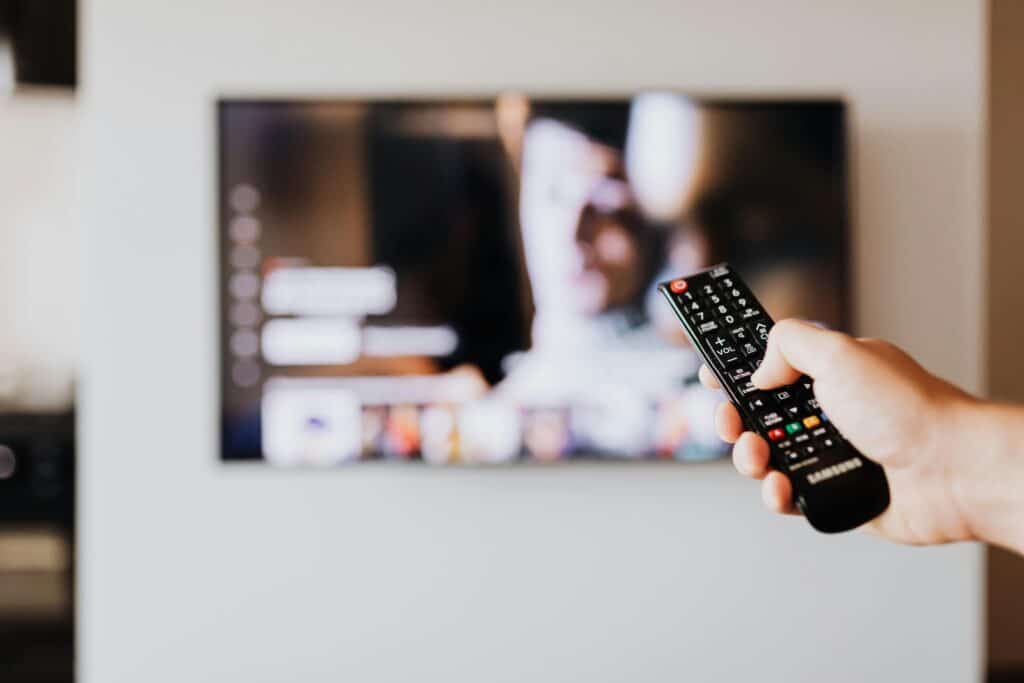
Performance TV is a powerful advertising strategy—especially when leveraged alongside other digital marketing tools. Digital Remedy works closely with growth-focused marketers to leverage performance TV to effectively drive real-world results and maximize ad spend/campaign performance.
Our digital marketing platforms centralize each aspect of the media management and activation process, allowing you to easily track your metrics. With full-service account management and support, you can expertly increase your audience scale with ease: connecting your brand messaging to the right audiences with relevant content at just the right time. Get in touch with a Digital Remedy team member and learn more today.
Performance marketing has grown in popularity over the last decade, as marketing budgets have been slashed to maximize return on investment. While brand awareness is important, many marketers are focused on driving (and measuring) bottom-funnel actions, such as website visits, in-store visits, and purchases. Improvements in measurement for once-considered upper-funnel media are coming fast and furious. These improvements show that lower-funnel media can have branding impacts, and upper-funnel media can have performance impacts.
In short, more measurable real-world results and more granular reporting for marketers. Performance TV allows marketers to deliver ads to target audiences, measure campaign performance, and attribute bottom-funnel results. Two main benefits of performance TV are the ability to:
Performance TV advertising is done through connected TV (CTV) devices that help to attribute and report on those campaigns. Performance CTV provides a unique opportunity for marketers to reach highly-engaged audiences.
CTV offers the high-impact, brand storytelling power of traditional TV plus the targeting, analytics, and interactivity of digital to provide a compelling environment for audiences to engage with messaging alongside premium content.
“Linear TV and CTV are converging; however, similar to the shifting holiday season, which is promoting earlier shopping each year, that doesn’t mean it has made what to buy, where to buy, and whether or not you have the best deal clear for media buyers (and consumers), which is the case for advanced TV.”
–Matt Sotebeer, Chief Strategy Officer, Digital Remedy
For brands looking for new ways to maximize their marketing efforts, CTV is the perfect channel.
“We’re seeing brands start to gear up for Black Friday and Cyber Monday and look toward new channels to leverage. CTV is definitely top-of-mind for these advertisers as long as their investment can be backed up by performance. This makes attribution and optimization on this channel more important than ever.”
– Ben Brenner, VP of Business Development & Strategy, Digital Remedy
CTV’s ability to merge the often-separated performance and brand marketing worlds—including its inherently addressable nature—is redefining the digital ad space and giving marketers a way to take their campaign measurement to the next level.
Finding the right performance CTV partner can make all the difference in optimizing your media strategy and maximizing ROAS in this fast-growing, highly-profitable market. While many ad tech vendors offer different solutions, not all of them have the full scope of resources to make the most of advertising on this medium. Digital Remedy offers first- and third-party data integrations, direct access to premium OTT publishers, real-time optimization, and granular, transparent bottom-funnel reporting through Flip, our performance OTT stack.
Digital Remedy provides comprehensive campaign performance reporting and data-driven capabilities to help advertisers and agencies connect with target audiences at the best time.With Flip, brands gain access to a sophisticated reporting dashboard to monitor their campaigns and real-time performance insights to optimize towards the KPIs that matter most. Flip provides a new standard in tracking, transparency, and results, including:
With these valuable insights, marketers can make more effective optimizations and investment decisions—to effectively grow their business and drive measurable campaign performance by leveraging the biggest screen in the home to deliver brand messaging.
Download the full report for full insights, including myths surrounding CTV. Interested in learning more? Watch our Digital Dish episode or speak to a member of our team.